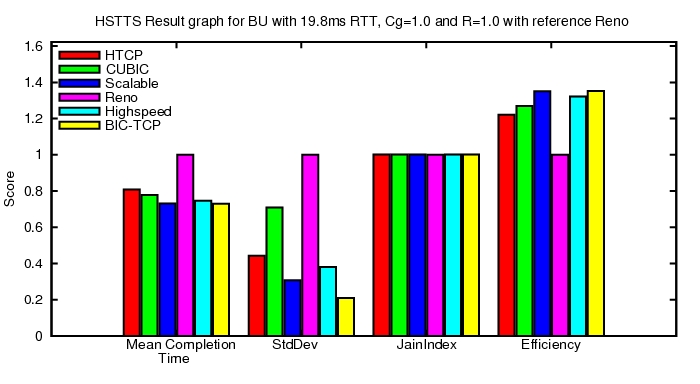HSTTS: High Speed Transport protocol Test Suite
Authors
This software is currently developed by Romaric Guillier, PhD student advised by Pascale Vicat-Blanc Primet. The MPI related part are developed by Ludovic Hablot
Description
TCP provides a fully distributed congestion control protocol which statistically share available bandwidth fairly among flows. TCP was designed first and foremost to be robust. When congestion is detected, TCP solves the problem by drastically reducing the output rate, but at the expense of performance. For example, for a standard TCP connection with 1500-byte packets and a 100ms round-trip time, achieving a steady-state throughput of 10 Gbps would require an average congestion window of 83,333 segments, and a packet drop rate of at most one congestion event every 5,000,000,000 packets (or equivalently, at most one congestion event every 1.66 hours). This means that in the context of FTTH and large-scale computing enhanced TCP variants will have to be used.
To solve the problem of TCP in very high speed optical networks, protocols enhancements and alternative congestion control mechanisms have been proposed.
Most of them are now implemented in current operating systems. But congestion control is the most important and complex part of a transport protocol. All the proposed variants are neither equivalent nor suited for every environment or every application. Moreover they may not cohabit well. Many alternatives are proposed, but they are difficult to compare. The research community recognises that it is important to deploy measurement methods, so that the transport services and protocols can evolve guided by scientific principles.
This work aims at contributing to this methodological effort by proposing a methodology and a tool for these studies, and presenting some steps towards a benchmark design for innovative high speed transport protocols comparison. Our contribution concerns the definition of metrics, scenarios, experiments and pilot demonstration for high demanding distributed applications. The goal is to define and validate a benchmark for comparing different transport and congestion control approaches.
Implementation
HSTTS is a set of scenarios (implemented using NXE) that emulates the behaviour of some typical Grid and Internet applications on real high speed networks. It is designed to be an user-oriented test suite so the output are easily readable graphs that allow a user to find out which particular transport protocol is the best suited for its needs.
- TU:
The TU test enables the HSTTS user to check if all the configuration parameters from the \textit{txqueuelen} to the TCP buffer sizes are properly adjusted to get the best performance in GNU/Linux out of its hardware infrastructure.
- WM:
The Web surfing and interactive application considers a mix of big and small bidirectional transfers, initiated by human, with human delay constraints (response time for interactive communication)
- PP:
For the P2P content distribution context, we consider that sessions are initiated by humans but lot of machine to machine communications take place.
- BU:
Bulk data transfers and data staging applications correspond to machine to machine communication. For example, in Data Grid like LCG (for LHC) file size and data distribution are defined by the sampling rate of data acquisition.
- PA:
Interprocess communication and message passing applications correspond also to machine to machine communication. Here the communication are triggered by computations.

Publications
- Methodologies and Tools for Exploring Transport Protocols in the Context of High-Speed Networks
@InProceedings{GuillierMethodologies08,
author = {Romaric Guillier and Pascale Vicat-Blanc Primet},
title = {Methodologies and Tools for Exploring Transport Protocols in the Context of High-Speed Networks},
booktitle = {IEEE TCSC Doctoral Symposium},
month = {May},
year = {2008},
}
[bib][pdf]
- Towards a User-Oriented Benchmark for Transport Protocols Comparison in very High Speed Networks
@TechReport{RRGuillierBenchmark07,
author = {Guillier, Romaric and Hablot, Ludovic and Primet, Pascale},
title = {Towards a User-Oriented Benchmark for Transport Protocols Comparison in very High Speed Networks},
year = {2007},
month = {07},
pages = {39},
institution = {INRIA},
number = {6244},
type = {Research Report},
url = {http://hal.inria.fr/inria-00161254/fr/ },
note = {Also available as LIP Research Report RR2007-35},
}
[bib][pdf]
- High Speed Transport Protocol Test Suite
@Unpublished{PGuillierTestsuite07,
author = {Romaric Guillier and Pascale Vicat-Blanc Primet},
title = {High Speed Transport Protocol Test Suite},
note = {poster, SuperComputing 2007},
month = {November},
year = {2007},
}
[bib][pdf]
Acknowledgment
This work has been funded by the French ministry of Education and
Research, INRIA, and CNRS, via ACI GRID's Grid'5000 project , ANR HIPCAL
grant, the ANR IGTMD grant, IST EC-GIN project, INRIA GridNet-FJ grant, NEGST CNRS-JSP project.
Links
HSTTS is using the NXE software
